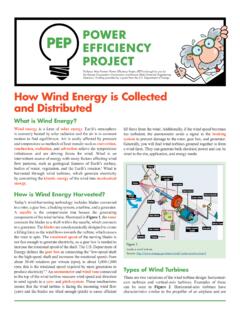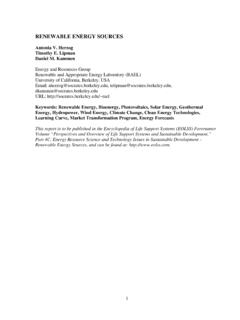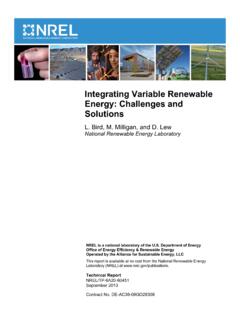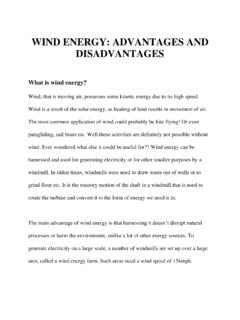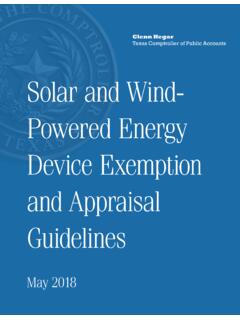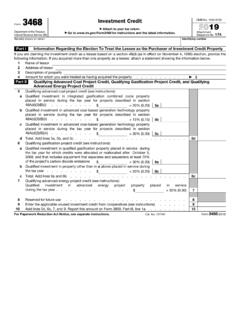Transcription of Wind Load Calculations for PV Arrays - Solar ABCs
1 wind Load Calculations for PV ArraysPrepared byStephen Barkaszi, Solar energy CenterColleen O Brien, EngineeringSolar America Board for Codes and American Board for Codes and Standards Report wind Load Calculations for PV ArraysPrepared byStephen Barkaszi, Solar energy CenterColleen O Brien, EngineeringJune 2010iiWind Load Calculations for PV ArraysDisclaimerThis report was prepared as an account of work sponsored by an agency of the United States government. Neither the United States government nor any agency thereof, nor any of their employees, makes any warranty, express or implied, or assumes any legal liability or responsibility for the accuracy, completeness, or usefulness of any information, apparatus, product, or process disclosed, or represents that its use would not infringe privately owned rights.
2 Reference herein to any specific commercial product, process, or service by trade name, trademark, manufacturer, or otherwise does not necessarily constitute or imply its endorsement, recommendation, or favoring by the United States government or any agency thereof. The views and opinions of authors expressed herein do not necessarily state or reflect those of the United States government or any agency a copy of the American Board for Codes and Standards ReportExecutive SummaryToday s photovoltaic (PV) industry must rely on licensed structural engineers various interpretations of building codes and standards to design PV mounting systems that will withstand wind -induced loads. This is a problem, because although permitting agencies require assessments of the structural attachment of Solar equipment to rooftops the safety and sufficiency of these attachments are not adequately addressed in any codes or standards.
3 The result is a multitude of code interpretations from a range of individuals and groups, often yielding different design loads for the same design specifications. It is important to evaluate equipment and attachment methods to ensure that PV equipment will remain attached to structures during windstorm events, and that additional loads or load concentrations do not exceed the structural capacity of the building. ASCE Standard-7-05 (American Society of Civil Engineers Standard 7-05) is the standard for wind forces on structures, but it does not provide adequate guidance to the design professionals and code officials tasked with assessing PV lack of guidance creates obstacles for the PV industry. The resulting problems include frustrated installers, unhappy customers, and wind -related structural failures.
4 In addition, uncertainty about what constitutes a safe and secure installation for a given wind load can slow or even stop the approval process for PV installations and complicates the training of code this report, we provide sample Calculations for determining wind loads on PV Arrays based on ASCE Standard 7-05. We focus on applying the existing codes and standards to the typical residential application of PV Arrays mounted parallel to the roof slope and relatively close (3 to 6 inches) to the roof surface. We do not address other array configurations or building-integrated PV. It will require much more work to gather information and develop standards specific to wind loading on rooftop PV installations. Although the information in this report does not completely solve the problem, it does provide initial guidance to designers and code officials.
5 In this paper, we recommend an approach for the structural design of roof-mounted PV systems based on ASCE Standard 7-05. We provide examples that demonstrate a step-by-step procedure for calculating wind loads on PV Arrays . The approach is applicable to PV modules mounted on rooftops that are no more than 60 feet high, when the PV array is oriented parallel to the roof surface, and when the mounting structure is sufficiently rigid. The PV array should be mounted a maximum of six inches above the roof surface. This distance is measured from the bottom of the PV frame to the roof surface, and is based on assumptions about typical mounting system configurations. The building should meet all requirements listed in Section of ASCE Standard 7-05. It is important that design professionals read and understand the appropriate codes and standards when designing rooftop PV systems.
6 This report is not meant to be a substitute for existing codes and standards. It is also important for design professionals to stay current with existing codes and standards, because we expect the body of information about designing PV systems to withstand local wind loading to grow rapidly in the near At present, we recommend basing the structural design of roof-mounted PV systems on the ASCE Standard 7-05 as follows: a. Section , main wind -force resisting system (MWFRS), is the recommended starting point for designing the PV mounting structure, with the PV module oriented above and parallel to the roof surface. ASCE Standard-7-05.. does not provide adequate guidance to the design professionals and code officials tasked with assessing PV installations.
7 IvWind Load Calculations for PV Arrays b. Section addresses wind loads on components and cladding. We recommend the use of Section and supporting Figures only for the design of the PV module attachment clips and hardware to the structure, and for calculating loads on individual PV modules. c. We do not recommend Section , , and Figure 6-21 for the design of PV systems. d. This report provides basic guidance for applying ASCE Standard 7-05 to existing codes and standards for the typical residential application of PV Arrays mounted parallel to the roof slope and relatively close (3 to 6 inches) to the roof We recommend wind tunnel testing be conducted for the most common rooftop PV installations to verify methods and Calculations .
8 The installation types include stand- off mounting parallel to the roof, stand-off mounting at an incline relative to the roof, and ballasted installations on flat roofs. 3. We recommend that codes and standards be modified to specifically address the mounting of PV Arrays to rooftops to eliminate potential barriers to market development in high wind regions. 4. We recommend that local jurisdictions and design professionals use the recommendations in this report to ensure continuity in interpreting existing codes and American Board for Codes and Standards ReportAuthor BiographiesStephen Barkaszi Stephen Barkaszi, is a Senior Research Engineer in the Solar energy Division at the Florida Solar energy Center (FSEC). Mr. Barkaszi s areas of research include photovoltaic (PV) module and system testing and certification, distributed generation, utility-interconnection issues, building-integrated PV, and roof-mounted PV Arrays .
9 He also conducts research on high performance buildings and has been involved in the Zero energy Homes (ZEH) efforts at FSEC since 1998. The ZEH projects have led to Disaster Tolerant Structures, which incorporate super energy efficient design with on-site generation for short and long-term power outages caused by wind storms and hurricanes in Florida or other coastal areas. Mr. Barkaszi s teaching activities include various seminars and short courses on PV, building energy efficiency, and building systems design. One popular offering is the week-long course Installing Photovoltaic Systems that FSEC offers each month. He received his and degrees in ocean engineering from the Florida Institute of Technology. Mr. Barkaszi is a licensed civil engineer in the state of Florida and previously managed the construction materials testing division for a private civil engineering O Brien Colleen O Brien, has worked in the PV industry since 1996.
10 She managed the Testing and Reliability group at PowerLight (now SunPower) for nine years, where she was responsible for mechanical and electrical testing of photovoltaic (PV) modules and mounting hardware. In that capacity, she ensured wind and seismic code compliance of PV mounting hardware, oversaw wind tunnel test programs, monitored and analyzed data from fielded PV systems, and evaluated emerging PV technologies. Ms. O Brien continued this work in her current position with the consulting firm BEW Engineering, where she has expanded the scope of her expertise to include PV energy forecasting and system code compliance. She earned a in mechanical engineering from the University of New Hampshire and is a registered professional mechanical engineer in the state of America Board for Codes and StandardsThe Solar America Board for Codes and Standards ( Solar ABCs) provides an effective venue for all Solar stakeholders.
